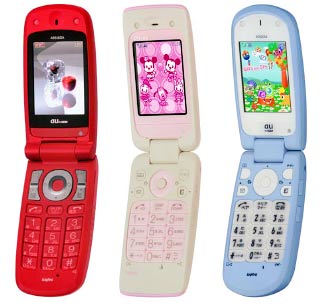 Building on the original teen-targeted Sweet handsets first introduced in January 2005, the companies have just announced three new models for release starting 1 February. One of the key features included in the first series was a GPS-aided application that included user location data in email sent from the phone (so that parents would know whether young Yukiko-chan was actually at juku (cram class) — or not). The second gen of these handsets goes a few steps further to include that function as well as the new Voice Input application and Hello Messenger, for starters. The latest CDMA 1X (3G) Sweet-series all have 1.3-megapixel cameras, are both BREW- and Flash-enabled and include a built-in security buzzer that boasts a screaming 98dB alarm in case of emergency.
Building on the original teen-targeted Sweet handsets first introduced in January 2005, the companies have just announced three new models for release starting 1 February. One of the key features included in the first series was a GPS-aided application that included user location data in email sent from the phone (so that parents would know whether young Yukiko-chan was actually at juku (cram class) — or not). The second gen of these handsets goes a few steps further to include that function as well as the new Voice Input application and Hello Messenger, for starters. The latest CDMA 1X (3G) Sweet-series all have 1.3-megapixel cameras, are both BREW- and Flash-enabled and include a built-in security buzzer that boasts a screaming 98dB alarm in case of emergency.
Perhaps the most interesting new feature that was announced, and missed by most other mainstream media, was the new OCR feature. You use the phone’s camera to scan text, such as an email address, URL or phone number, which can then be easily added to the onboard address book; this is a very handy feature. There is also a new “Camera Dictionary” BREW application that will also scan — and translate — English text into Japanese kanji characters as well. Now that is Sweet!
Safety features for children is a growing market niche and this series should prove very popular with both youthful customers and their parents (subscribers log in for full feature descriptions from the press release).


 Building on the original teen-targeted Sweet handsets first introduced in January 2005, the companies have just announced three new models for release starting 1 February. One of the key features included in the first series was a GPS-aided application that included user location data in email sent from the phone (so that parents would know whether young Yukiko-chan was actually at juku (cram class) — or not). The second gen of these handsets goes a few steps further to include that function as well as the new
Building on the original teen-targeted Sweet handsets first introduced in January 2005, the companies have just announced three new models for release starting 1 February. One of the key features included in the first series was a GPS-aided application that included user location data in email sent from the phone (so that parents would know whether young Yukiko-chan was actually at juku (cram class) — or not). The second gen of these handsets goes a few steps further to include that function as well as the new